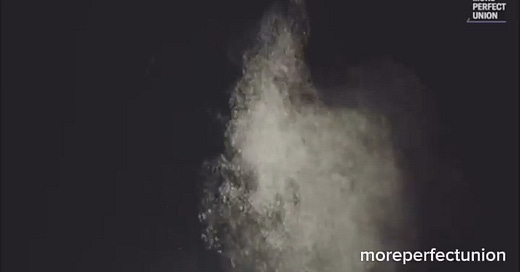In the corporate world, sometimes the most audacious scandals involve the most routine paperwork. This is the story of how one of America's most trusted companies may have engineered a legal maneuver to escape responsibility for thousands of cancer cases while leaving victims fighting battles on two fronts—against disease and against a justice system that many argue is failing them.
The Red River Subsidiary
In August 2024, Johnson & Johnson created a subsidiary in Texas called Red River Telc. The managers were all based at J&J headquarters in New Jersey. In Texas, there were no employees, no products, and no real business operations—just paperwork.
When investigators called the registered phone number for Red River, they were greeted with: "You're speaking to CG Corporation, so we're not Johnson & Johnson, we're CG Corporation".
A month later, it all made sense. A Johnson & Johnson subsidiary filed for bankruptcy protection for the third time since 20211. This raised an important question: Why would one of America's most profitable companies—worth more than $350 billion—create a subsidiary only to declare it bankrupt?
The Baby Powder Legacy
For generations, women like Marianne trusted Johnson & Johnson's baby powder. It wasn't just a product; it was a ritual passed down from mother to child. The marketing worked so well that by the late 1960s, an internal memo crowned baby powder "the cornerstone of Johnson & Johnson's entire baby business".
"I have two girls, and I also used it on them. And then in turn, they used it on their sons, their children too," Marianne recounted.
The product itself was simple: talc, a mineral mined from the earth. But in 1966, academics published a troubling discovery. Talc had no medicinal value. Worse, it was linked to three deaths.
The Hidden Danger
The warning made its way through Johnson & Johnson's executive offices. There was growing concern starting in the 1970s about asbestos being in talc because of testing done by the FDA.
Jessica Dean, a plaintiff's attorney who has been fighting Johnson & Johnson in court for over a decade, explained: "The problem is that talc and asbestos often grow together. It has been known for decades to be a common impurity in talc".
The Health Implications Were Severe
Asbestos causes mesothelioma, a cancer that destroys organ linings from within. It's also linked to ovarian cancer. No amount of processing can make it safe1.
"You're mixing a carcinogen into a powder product designed to be used on children and designed to be used in our homes. And that's the problem at the core of what Johnson & Johnson did," Dean stated.
The Government Intervention
The government had concerns early on. In 1972, they called a meeting to review an FDA study that found asbestos in a huge chunk of products on store shelves. Five members of J&J attended, along with other industry groups.
According to the meeting summary, an industry lobbyist pushed to keep the FDA study secret, saying it could cause "great economic hardship for the companies." J&J claimed that the government's positive asbestos tests were faulty and that their own tests came back negative.
"That's more or less the company's position on testing to this day," noted the investigative report.
Dean countered this claim: "They will boast, look at how many tests we've done that don't show asbestos. And they use tests that were underpowered. A simple example I can think of is if you are trying to weigh a feather, you don't use a bathroom scale. It's not going to show up. You need to have something that is more sensitive".
The Cover-Up
Coming out of that meeting, the government agreed to let companies self-test. Johnson & Johnson promised to share their own records, swearing they found nothing concerning.
But according to Dean, "When they made that promise, they had already done testing revealing asbestos in the actual samples from Dr. Lewin at the FDA. In fact, a third of the fibers in baby powder were tremolite asbestos".
She added: "There were over 400 samples evidencing asbestos in talc that J&J knew about after they promised our government 'will give you everything.' And we now know they didn't give them any of it".
The Human Cost
Real people paid the price. Marianne battled ovarian cancer in 2008, only to see it return four years later.
"Never thought that I would have cancer. It was a shock," she said. "First time, the tumor was the size of a cantaloupe".
The emotional toll was devastating: "One of the hardest things was... I couldn't see my grandchildren because they were both in school. And I couldn't be around people that might have germs. I didn't see friends".
When asked what she would say to Johnson & Johnson executives, her answer was simple: "Why? Why did you lie? Why did you keep it hidden for so long?"
The Marketing Strategy
The answer may lie in J&J's own documents. Dean revealed: "There's a series of documents. And we even found a videotape of something called Baby Camp. One of the documents outlines trust".
"They said the way you get that emotional trust is the mother-baby bond, is making people, when they think of Johnson & Johnson, think about the care a mother has for their brand new infant. And that if you can tap into that, you're going to make bags of money. And that's not something I came up with. That's their visual depiction of a bag of money with the words mother-infant bond on it".
Dean continued: "And look, if they had a safe product, go for it. But once you know concretely 60 years ago that there is an impurity in that powder you're crushing and putting in a bottle to be put on babies and that that impurity has been known to kill people, this becomes horrific. And they built this as the backbone of a company that we all rely on".
The Legal Maneuvering
For decades, the strategy worked like clockwork. Concerns about talc would surface, and J&J would perfect the art of making them disappear.
"They would hire experts that they believed they could control, and that's the word they used in their own documents," Dean explained. "They would go after anyone who tried to show the truth and say, 'let's compromise them.' Again, that is the word they used over and over and over again".
But by the late 2010s, the strategy fell apart. Cancer victims started winning lawsuits against Johnson & Johnson. And then, in 2018, the dam broke when a St. Louis jury awarded $4.1 billion in punitive damages and $550 million in compensatory damages to 22 women and their families who claimed asbestos in Johnson & Johnson's talc products caused their ovarian cancer.
The Texas Two-Step
This brings us back to the Texas subsidiary. Legal experts believe it's the endgame of a decades-long strategy that could help J&J escape responsibility for thousands of cancer cases. Meanwhile, thousands of women are left fighting battles on two fronts—against disease and against a justice system that many believe is failing them.
As one legal expert put it: "If a company can get by with these types of tactics, then the American people are in serious danger".
This investigative report was brought to you by News and Knees Substack. Our independent journalism relies on reader support to continue bringing you these important stories. If you value this type of in-depth reporting, please consider subscribing to support our work. Every subscription helps us hold powerful corporations accountable and give voice to those who might otherwise go unheard.













Share this post